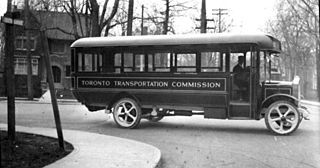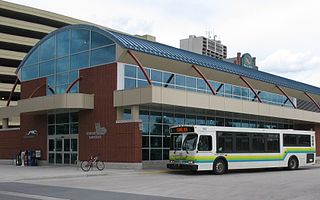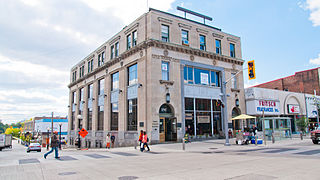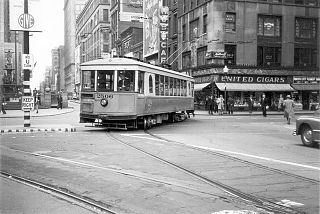
The Hamilton Street Railway commonly known as the HSR is a public transport agency in Hamilton, Ontario, Canada. The name is a legacy of the company's early period, when public transit in Hamilton was primarily served by streetcars. Although streetcars are no longer used in the city today, the HSR operates bus and paratransit services, with a ridership of 21 million passengers a year. The HSR uses the Presto card as its method of fare payment, allowing for connections with GO Transit and other transit systems in the Greater Toronto area.

Toronto Transportation Commission (TTC) was the public transit operator in Toronto, Ontario, Canada, beginning in 1921. It operated buses, streetcars and the island ferries. The system was renamed the Toronto Transit Commission (TTC) in 1954.
The Greater Dayton Regional Transit Authority, formerly known as the Miami Valley RTA, is a public transit agency that generally serves the greater Dayton, Ohio area. The GDRTA serves communities within Montgomery County and parts of Greene County, Ohio, USA. There are 18 routes. RTA operates diesel and electric trolley buses seven days a week, 21 hours a day, and provides services to many citizens within the area. RTA's current CEO is Bob Ruzinsky. In 2022, the system had a ridership of 5,656,600, or about 18,900 per weekday as of the first quarter of 2023.

A tourist trolley, also called a road trolley, is a rubber-tired bus designed to resemble an old-style streetcar or tram, usually with false clerestory roof. The vehicles are usually fueled by diesel, or sometimes compressed natural gas.

Transit Windsor provides public transportation in the city of Windsor, Ontario, Canada as well as LaSalle, Essex, Kingsville, Amherstburg and Leamington and serves more than 6 million passengers each year, covering an area of 310 km2 (120 sq mi) and a population of 235,000. They operate a cross border service between the downtown areas of Windsor and Detroit, Michigan via the Tunnel Bus, and service to events at Detroit's Comerica Park, Little Caesars Arena, Huntington Place, and Ford Field. The Windsor International Transit Terminal neighbours with the Windsor International Aquatic and Training Centre.

The Cincinnati Car Company or Cincinnati Car Corporation was a subsidiary of the Ohio Traction Company. It designed and constructed interurban cars, streetcars (trams) and buses. It was founded in 1902 in Cincinnati, Ohio. In 1928, it bought the Versare Car Company.

CT Transit is a public transportation bus system serving many of the metropolitan areas and their surrounding suburbs in state of Connecticut. CT Transit is a division of the Connecticut Department of Transportation, although it contracts a number of private companies for most of its operations. CT Transit began operations in 1976 as Connecticut Transit after the Connecticut DOT's acquisition of the Connecticut Company that year. Although initially serving only the Hartford, New Haven, and Stamford areas, various local companies and private operators became part of the CT Transit system from the 1970s to the early-2000s. CT Transit's service now extends across much of Connecticut, although specifically around the cities of Bristol, Hartford, Meriden, New Britain, New Haven, Stamford, Wallingford and Waterbury. In 2015, CT Transit began operation of CT Fastrak, the first bus rapid transit system in Connecticut and the second in New England.

Cincinnati Street Railway (CSR) was the public transit operator in Cincinnati, Ohio, from 1859 to 1952. The company ceased streetcar operations and was renamed Cincinnati Transit Company.

The Kitchener Public Utilities Commission was the municipal public utilities commission for the city of Kitchener, Ontario, Canada, as well as the surrounding area. Its former office in downtown Kitchener, constructed in 1931 in Beaux-Arts style, has been designated under the Ontario Heritage Act as both historically and architecturally significant, and is one of the Kitchener's few surviving historic public buildings.

Streetcars or trolley(car)s were once the chief mode of public transit in hundreds of North American cities and towns. Most of the original urban streetcar systems were either dismantled in the mid-20th century or converted to other modes of operation, such as light rail. Today, only Toronto still operates a streetcar network essentially unchanged in layout and mode of operation.

The Third Avenue Railway System (TARS), founded 1852, was a streetcar system serving the New York City boroughs of Manhattan and the Bronx along with lower Westchester County. For a brief period of time, TARS also operated the Steinway Lines in Long Island City.

The Maryland Transit Administration was originally known as the Baltimore Metropolitan Transit Authority, then the Maryland Mass Transit Administration before it changed to its current name in October 2001. The MTA took over the operations of the old Baltimore Transit Company on April 30, 1970.

Like most large cities in the United States, there existed a large network of streetcars in Cleveland in the first half of the 20th century. The streetcar lines in Cleveland, Ohio were operated by the Cleveland Railway, which was formed in 1910 with the merger of two companies. The Cleveland Railway converted a few streetcar lines in the 1930s, but the onset of World War II stopped any further conversions.

The Dayton trolleybus system forms part of the public transportation network serving Dayton, in the state of Ohio, United States. Opened on April 23, 1933, it presently comprises five lines, and is operated by the Greater Dayton Regional Transit Authority, with a fleet of 45 trolleybuses. In 2022, the system had a ridership of 1,813,600, or about 6,200 per weekday as of the first quarter of 2023.

Streetcars operated by the Cincinnati Street Railway were the main form of public transportation in Cincinnati, Ohio, at the end of the 19th century and the start of the 20th century. The first electric streetcars began operation in 1889, and at its maximum, the streetcar system had 222 miles (357 km) of track and carried more than 100 million passengers per year. A very unusual feature of the system was that cars on some of its routes traveled via inclined railways to serve areas on hills near downtown. With the advent of inexpensive automobiles and improved roads, transit ridership declined in the 20th century and the streetcar system closed in 1951.

The Danbury and Bethel Street Railway was a streetcar transit operator serving the greater Danbury, Connecticut, area, originally chartered in 1886. It was one of the few trolley companies to remain independent of the Connecticut Company consolidation of transit lines throughout the state. Electric trolley service between Danbury and Bethel began in 1887. The streetcar line connected to the Danbury and Harlem Traction Company at the Fairgrounds, but no service was provided and the line was abandoned by 1910. The Danbury and Bethel Street Railway faced its first financial difficulties in 1914 as ridership declined with the closure of local factories. The construction of an aborted extension to Bridgeport had nearly exhausted the railway's cash reserves. The company was purchased by J. Moss Ives in 1918 with the intention of bringing the operation back to profitability. The first buses were ordered and put into operation in 1912 between Main Street and Lake Avenue in Danbury. Ives reorganized as the Danbury and Bethel Traction Company in 1925. When the proposal to replace all remaining streetcar lines with bus operation was announced, the trolley motormen all went on strike in November 1926. The work stoppage did not affect the transition, and by the end of 1926 all streetcar operation had been abandoned, making it the first line in Connecticut to completely convert to bus operation.
Connecticut Railway and Lighting Company was a streetcar and bus transit operator serving the region around Bridgeport, Norwalk, Derby, New Britain and Waterbury, Connecticut. It was formed in 1901 by United Gas Improvement Company of Philadelphia to manage the streetcar operations of the Connecticut Light and Power Company, which at the time included Central Railway and Electric Company, Norwalk Street Railway, and the Waterbury Traction Company. The newly formed Connecticut Railway and Lighting acquired Bridgeport Traction Company, Derby Street Railway, Milford Street Railway, Shelton Street Railway, Meriden, Southington and Compounce Tramway Company, and the Cheshire Street Railway. Connecticut Railway and Lighting was leased to the Consolidated Railway and in turn the Connecticut Company between 1906 and 1936. Streetcar operations were discontinued in 1937 when all lines were converted to bus. Transit operations continued until 1972, when all remaining bus operations were suspended and taken over by Connecticut Transit, except in Bridgeport- by the Greater Bridgeport Transit District in 1975.
The Waterbury Traction Company was a streetcar transit operator serving the region around Waterbury, Connecticut. Originally formed in 1884 as the Waterbury Horse Railroad Company, which began service in 1886. The company was reorganized in 1893 as the Waterbury Traction Company, rebuilding and electrifying its routes by the summer of 1894.

Public transit has taken numerous forms in Columbus, the largest city and capital of Ohio. Transit has variously used passenger trains, horsecars, streetcars, interurbans, trolley coaches, and buses. Current service is through the Central Ohio Transit Authority's bus system, numerous intercity bus companies, and through bikeshare, rideshare, and electric scooter services.

















